Chapter four: Participatory monitoring
1. What is participatory monitoring?
2. The benefits of participatory monitoring.
3. Monitoring people's participation.
4. Steps to participatory monitoring.
1. What is participatory monitoring?
Participatory Monitoring is the systematic recording and periodic analysis of information that has been chosen and recorded by insiders with the help of outsiders.
Participatory Monitoring measures progress
The main purpose of Participatory Monitoring is that it provides information during the life of the project, so that adjustments and/or modifications can be made if necessary.
Sun
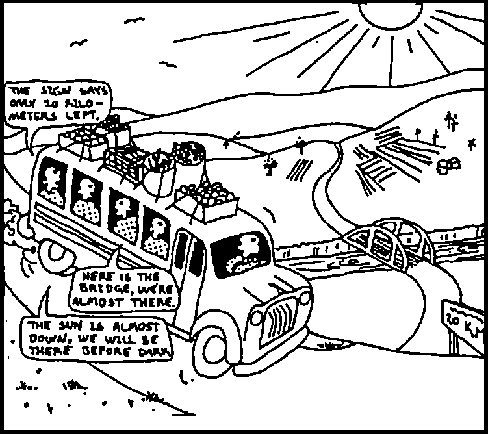
Take the example of a bus trip from one community to the other. When passengers can see out the windows, they can monitor progress by observing the passing landscape, reading the road signs, and watching the movement of the sun across the sky. Monitoring these kinds of information on a bus trip lets them know whether they are heading in the right direction.
Participatory monitoring is having all passengers on the bus know their destination and decide how they will measure their progress.
Rain
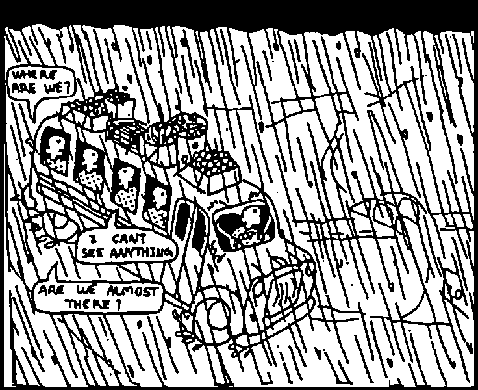
But, suppose a rainstorm made it impossible for passengers to see out the windows. The bus would be moving, but passengers would be unable to know if they were on the right road, or headed in the right direction. That is what it would be like without monitoring. If only the bus driver of the bus knows where the bus is going, and measures progress without discussion with the passengers, that is like monitoring without participation.
Provides information for decision makers
Keeping track of activities by recording information on a daily, weekly, monthly or seasonal basis, and taking the time to Stop and analyze the information monitored can provide important immediate feedback, and can be used in the future for Participatory Evaluations.
For example, a community charcoal marketing cooperative might monitor monthly sales over a year. This might show that sales were low over a three month period. They would realize that this three month period is the rainy season, when transportation is a problem. Using this information, the community might decide to transport and store charcoal close to the market before the rainy season.
Information is periodically analyzed
Participatory Monitoring is not only keeping records. It is also stopping at set times to analyze (add up, discuss, integrate) information. The time to Stop and analyze will vary according to the nature and/or seasonality of activities.
For example, projects with small forest based enterprise activities may have daily recording of cash, and monthly balancing of the records. Reforestation activities may only require record keeping during nursery production and planting periods, with an analysis at the end of each planting season.
Agreement on the objectives ant activities is necessary
Before Participatory Monitoring begins, the community must understand why they are monitoring. Information should keep everyone informed of progress (or lack of progress) toward planned objectives and activities.
Insiders choose the terms of measurement
When the terms of measurement, (kilos, grams, guntas, sacks, cans, pounds, bundles, etc.) are chosen by insiders, the information is better understood. The chances of the monitoring continuing in the future are more likely.
Insiders choose the terms of measurement
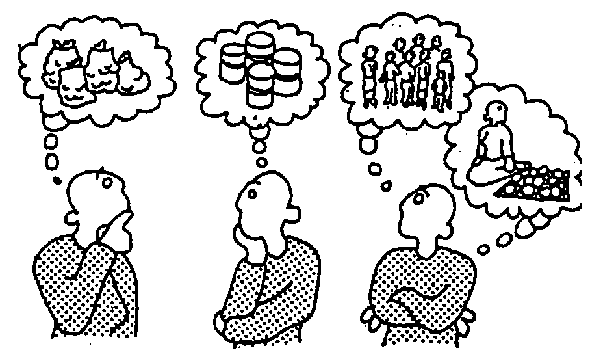
If this kind of information is required by outsiders, they can translate the insiders' terms of measurement into terms that they use. For example guntas, bags, and bundles can be translated into kilograms or pounds.
Broadly examines progress towards objectives ant activities
Insiders, given the opportunity, have the ability to combine qualitative (descriptive) information with quantitative (numbers) information, providing a more complete analysis.
For example, an objective may be to reduce soil erosion by wind, and the activity to establish 400 kilometres of windbreaks. Information from monitoring in the first year might show that, as planned, 100 kilometres of windbreaks have been established around farmer's fields. This is important and useful information. It shows that activities are going according to plan. But it is may not be complete information if the objective of reducing soil erosion is not also considered. Farmers may be experiencing increased soil erosion in fields outside the windbreak. This information can bring up the question of whether the windbreaks, as currently planted, are a worthwhile activity or should be modified in some way. It may call for an early evaluation.
Broadly examines progress towards objectives ant activities
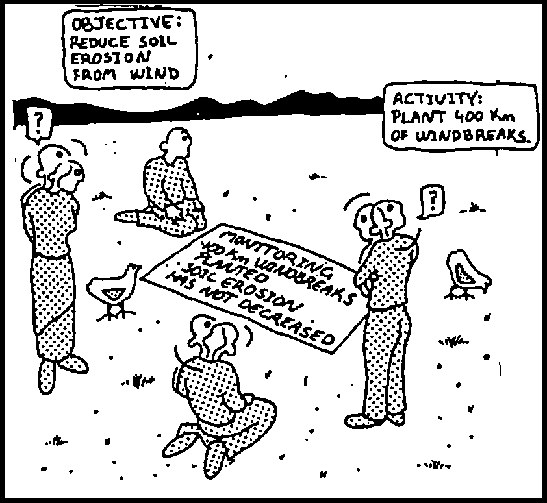
Before another 300 km. of windbreaks are planted, important questions can be answered, and the activities and/or objectives can be modified. A potential disaster can become a success!
2. The benefits of participatory monitoring.
Provides an ongoing picture
Participatory Monitoring provides an ongoing picture that allows the community to determine whether activities are progressing as planned. It may also show when activities are not leading to objectives, so that early adjustments can be made.
Problems are identified and solutions sought early
Participatory Monitoring provides an "early warning" which identifies problems at an early stage. Solutions can then be sought before the problems get out of hand. This is especially important with new technologies that may have negative effects after introduction.
Good standards are maintained
Continuous feedback throughout the life of the activities ensures that the quality of the activities is sufficient to provide good results. For example, seedling survival surveys in the first few months after seedlings are outplanted can indicate whether the quality of nursery stock and/or planting and stock handling are good. Survival surveys done when the most critical limits to survival of seedlings has passed, can indicate whether the protection and management are sufficient
Resources are used effectively
Participatory Monitoring can show the resources that are required to produce a certain effect, or how necessary resources can be distributed differently to get a better effect.
Complete picture of project is produced
When insiders are in control of monitoring, the results are examined relative to past experience. This broader picture enhances all other benefits of monitoring.
Information base for future evaluations
Both insiders and outsiders can benefit from the information base provided by Participatory Monitoring, which can provide realistic information while also showing trends.
| Sometimes things will get worse before they get better. Try not to be too hasty about giving up something that doesn’t appear to be working right away! Sometimes targets have been unrealistic, and will have to be reconsidered. Remember to think of both short-term and long-term effects. |
3. Monitoring people's participation.
Outsiders monitor participation
Both insiders and outsiders can monitor participation, but it may be for very different reasons. Outsiders may be interested in equal community representation in decision making, while insiders may be interested in equal distribution of costs and benefits.
Participation is often an outsider objective because they are concerned with equal representation of all elements and groups in the community. Outsiders may want to ensure, through monitoring participation, that all involved and affected people in the community are represented when decisions regarding activities are made.
Because "participation" is a process that emerges and develops as the activities progress information needs regarding participation may undergo significant change over time.
For example, increases and decreases in turnout at community meetings are not always an effective indicator of participation. There may be enthusiastic turnout at meetings when the activities are first introduced to the community. However, as groups and committees take over decision making, the community only has to be kept informed. Therefore the turnout at meetings may drop off, especially if things are going well.
Insiders monitor participation
Insiders may wish to know who participates in communal activities, so that benefits can be equitably distributed.
In many instances, community forestry activities will be done using the volunteer labour of community members. Those who contribute their labour may wish to be acknowledged in some way. They may also want sanctions taken against those who do not volunteer labour. For example, those who contribute labour in the tree nursery might receive free seedlings, while those who do not contribute labour might pay for the seedlings.
Insiders and outsiders monitor participation together
Whether monitoring participation is important to insiders or outsiders it makes sense to have insiders define it and help either measure it (if it is information important to them) or help outsiders identify indicators. When insiders choose participation indicators, they are likely to be more locally relevant than indicators chosen by outsiders.
For example, individual participation cannot always be measured in hours. One person may supply skilled labour for a shorter period of time and still be considered by others to have equally participated. Communities may choose to evaluate participation based on the skill and quality of work, rather than the time spent. A carpenter's time contribution may not be considered equal to an unskilled labourer's time contribution. The community may feel that a leader who has more obligations should have a larger share of the benefits.
| While Participatory Monitoring can be introduced at any stage of
activities, it is best introduced at the beginning stage, before activities are
implementated. At this stage, preparations are made for how and who will do the data
collection, and when the periodic analysis will take place. After implementation, when the
activities have begun the recording begins. At set periods, which can be either daily,
weekly, monthly, or seasonally, the information that is being recorded is analyzed. If the activities are already ongoing, there are still many benefits to be had from introducing Participatory Monitoring. If the current monitoring is not working well, if the information that is generated is not useful to insiders, or if other PAME approaches are being tried, introducing Participatory Monitoring may still be appropriate. It may be useful to compete the kinds of information and the value of the information before and after participatory monitoring! |
4. Steps to participatory monitoring.
Take the time to prepare and plan monitoring. It helps everyone know why they are monitoring, and how it will be done. The first meeting (see Group Meetings Tool 1) to plan for monitoring can include all those directly involved in the activities as well as other interested groups. But it will be concentrated on those directly involved or those selected by the groups who will be responsible for monitoring. Planning for monitoring can use a framework much like those used for Participatory Baselines and Participatory Evaluation. This framework is explained in the following steps.
| First step 1 |
Discuss reasons for monitoring.
Review the benefits and purpose of monitoring, so that insiders can decide for themselves whether monitoring will help them.
| Second step 2 |
Review objectives and activities.
If PAME has been continually used, the insider objectives and activities will have been established during the Participatory Assessment. If insiders have not previously been involved, the objectives and activities as established by outsiders can be reviewed and discussed by insiders. A Participatory Assessment may be necessary if insiders and outsider objectives are very different.
| Third step 3 |
Develop monitoring questions.
After objectives and activities are reviewed, discuss the information needed to help know if activities are going well. Focus on the questions "What do we want to know?" and "What do we monitor that will tell us this?".
The facilitator can write (or draw), on large sheets of paper or a blackboard, monitoring questions generated around each objective and activity. There should be agreement by the group on each monitoring question. If many questions are generated they can be ranked in order of importance.
Develop monitoring questions
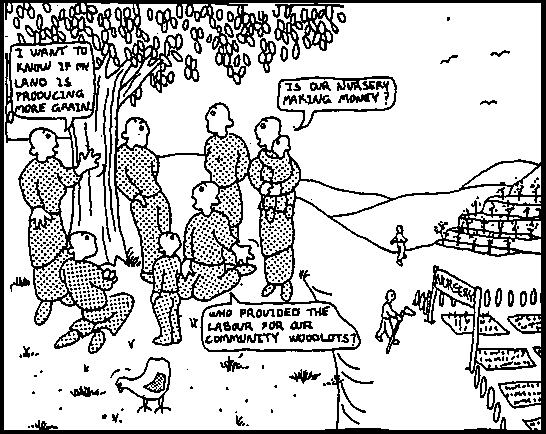
| Fourth step 4 |
Establish direct and indirect indicators.
For each monitoring question, determine direct and/or indirect indicators that will answer the monitoring questions. Indicators are described in chapter 3.
| Fifth step 5 |
Decide which information gathering tools are needed.
For each lay indicator or monitoring question, the most appropriate information gathering tool must be chosen. Remember one tool can gather information that answers many monitoring questions. Some of the information gathering tools useful in Participatory Monitoring are:
| Tool 11 | Community Environmental Assessment |
| Tool 12 | Survival Surveys |
| Tool 15 | Farmer's Own Records key |
| Tool 16 | Nursery Record Books |
| Tool 17 | Community Financial Accounts |
| Fifth step 6 |
Decide who will do the monitoring.
Monitoring may require people with specific skills such as bookkeeping or mathematics. It will also require a certain amount of labour (time) from people. Those with the skills and the time can be identified. There may have to be compensation for the task of monitoring. It might be part of the job of a paid nursery person, or the community members responsible for monitoring might receive free seedlings from the nursery.
Decide who will do the monitoring
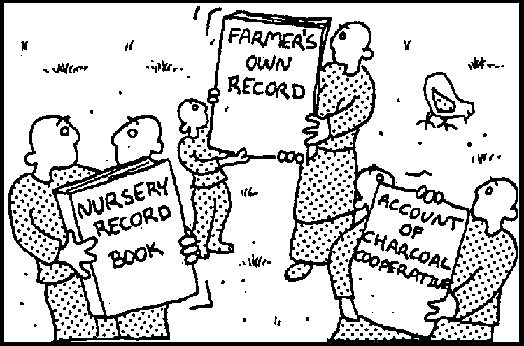
| Seventh step 7 |
Analyze and present results.
It is important that information monitored be analyzed at specific times throughout the activities. The analysis can be discussed at community meetings, posted or put in community newsletters. The community will then know whether or not activities are progressing as planned or if changes or modifications are required.
Total distributed in community 1985-1989
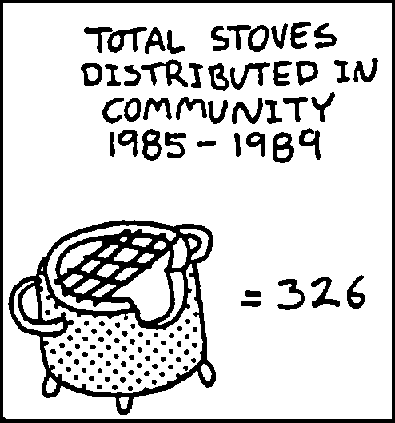
Stoves distributed in community 1985-1989
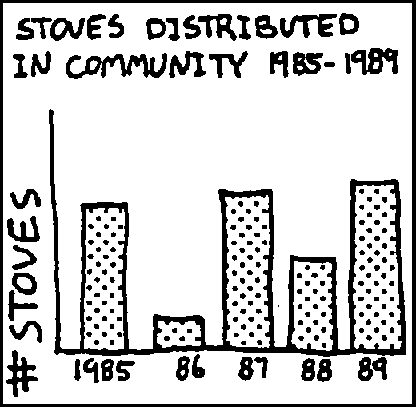
Chapters Six and Seven deal with information analysis and presentation.
Chapter five: Participatory evaluation
1. What is participatory evaluation?
2. The benefits of participatory evaluation.
3. Steps to participatory evaluation.
1. What is participatory evaluation?
Insiders take the lead in participatory evaluation
A Participatory Evaluation is an opportunity for both outsiders and insiders to stop and reflect on the past in order to make decisions about the future. Insiders are encouraged and supported by outsiders to take responsibility and control of:
• planning what is to be evaluated
• how the evaluation will be done
• carrying out the evaluation
• analyzing information and presenting evaluation results.
Insiders already, intuitively and informally evaluate in light of their own individual and/or group objectives. This is because:
• community forestry activities often require involvement and inputs from insiders
• it is ultimately insiders who reap the benefits and bear many of the costs of the project
• insiders choose whether to continue or discontinue activities when the outsiders leave.
Thus, it makes sense for outsiders to help insiders conduct an effective evaluation. With the results of evaluation, insiders may choose to continue activities, modify all or some, change the strategy, change the objectives, or discontinue activities.
Evaluations reflect on the past to help make decisions about the future
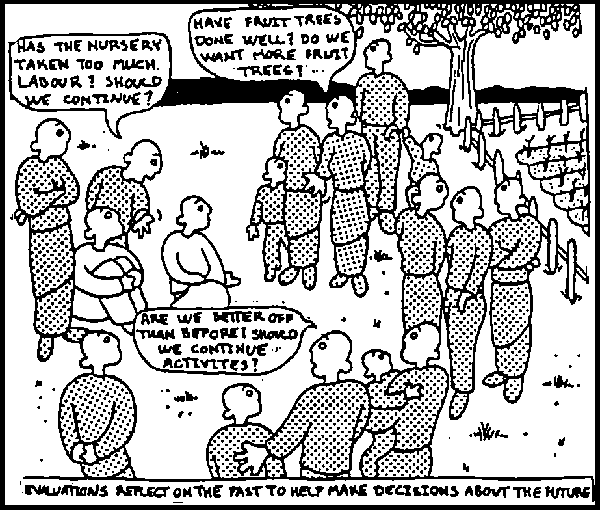
Outsiders facilitate Participatory Evaluations
Outsiders assist insiders in planning and conducting the evaluation. They lead but do not direct. They can provide the focus, the idea, and some help, intervening when assistance is required.
Participatory Evaluations are not conducted for the purpose of answering the questions that outsiders need answered. However, in many instances, insider and outsider evaluation questions may be the same and both may be answered through Participatory Evaluation.
Governments and donors may want very specific information, but both will need to know if the activities are relevant to the problems perceived by insiders and if they are likely to continue when the outsiders withdraw support.
Information to guide management decisions
A Participatory Evaluation should not be thought of as a final judgement on whether activities are successful or unsuccessful. The information should encourage changes and adjustments either during the life span of the activities, for future phases of the activities, or for future new activities.
In a Participatory Evaluation, people learn more about the things that have worked well, and why they worked. They also learn more about the things that haven't worked well, and why they didn't. When the people involved go through the process of examining, it is more likely that corrective measures will be implemented in the future because they are discovered and understood by the community.
For example, a Participatory Evaluation mid-way through the activities might reveal that fuel efficient stoves were only helpful to those who must pay for fuelwood. This information might be used in the next phase of activities, to offer those who collect fuelwood as a free good a less expensive alternative, such as construction of mud walls around the traditional three stone fire.
Information to guide management decisions
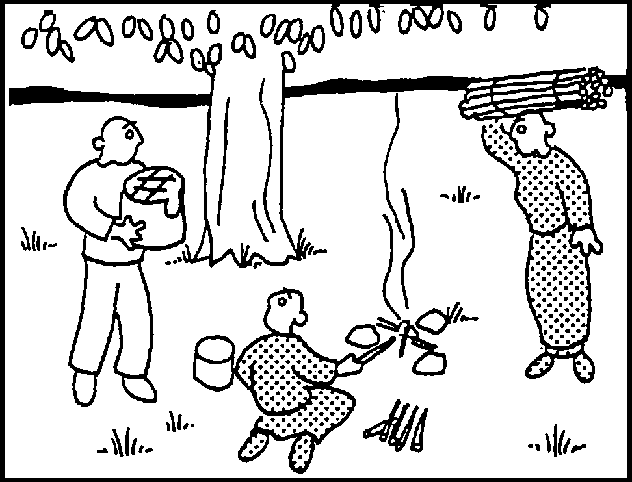
Both objectives and activities are considered
In a Participatory Evaluation, the overall and immediate objectives, their continued relevance, and the effectiveness of the activities are all taken into account.
For example, the overall objective might be to conserve existing forest resources, and the immediate objective to reduce household fuelwood consumption. The activities have tried to meet these objectives by introducing fuel efficient stoves. An evaluation can provide information such as the number of stoves currently being used, and the fuelwood saved. This information will let people know if their objective, to reduce household fuelwood consumption, has been achieved.
Evaluation is done in light of original objectives
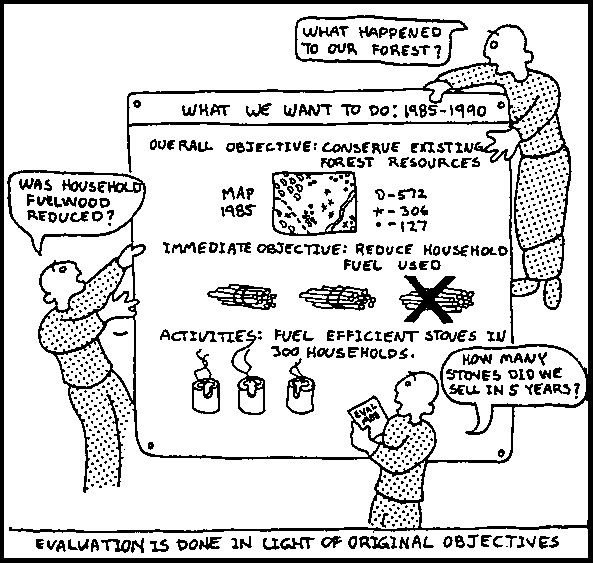
Other methods contribute to participatory evaluation
Much of the information from Participatory Assessments, Participatory Baselines, and Participatory Monitoring can be used in Participatory Evaluation.
For example, information from Participatory Assessments can be used to identify the original overall and immediate objectives, re-acquainting the community with their original analysis of the problems. Information from Participatory Baselines can provide information (such as average household fuelwood consumption before fuel efficient stoves were introduced) that is useful for comparison.
1985...Baseline
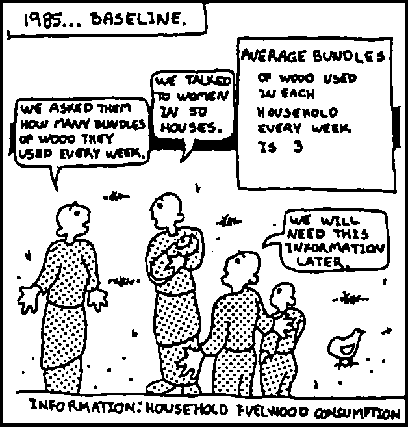
1990...Evaluation
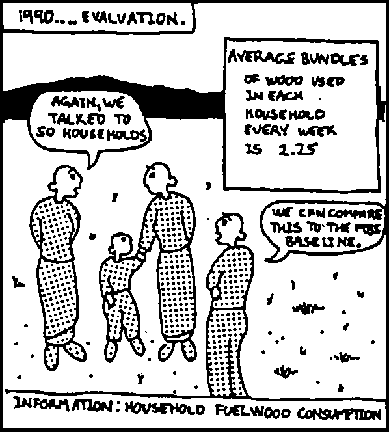
Information from Participatory Monitoring will give progressive trends and total amounts.
1985-1988 Monitoring
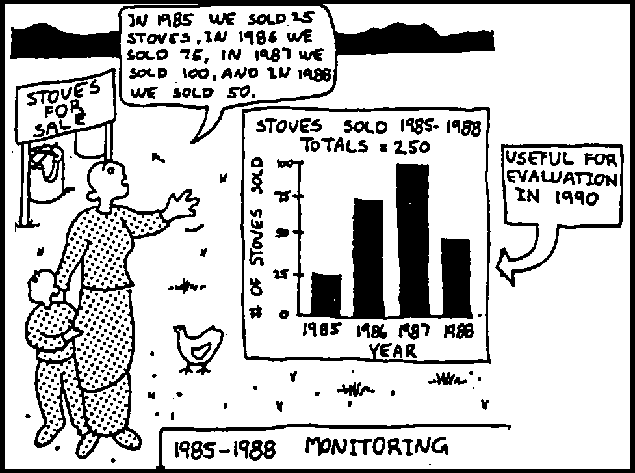
2. The benefits of participatory evaluation.
Better decision making by insiders
Participatory Evaluations, by examining the activities individually and relative to objectives, give insiders relevant and useful information. Helping them decide whether the objectives and/or activities should stay the same or change.
Insiders develop evaluation skills
Participatory Evaluation reveals community skills that were undervalued, and/or develops analytical skills needed to make good decisions. It helps insiders better organize and express their concerns and interests in ways outsiders can understand. This strengthens two way communication.
Outsiders have better understanding of insiders
Outsiders benefit from Participatory Evaluation as it complements and enriches their own evaluations. This is especially so when the outsiders objectives are self-help and sustainability. A Participatory Evaluation will let them know whether or not the community is likely to continue the activities when outsiders have left.
Participatory Evaluations also benefit field staff by providing support for the participatory approach. The insider perspective can by-pass any "filters of self-interest" that might be present and reach high level decision makers, providing them with the community's perspective, and encouraging a deeper understanding of community development.
Information flow with outsider evaluation
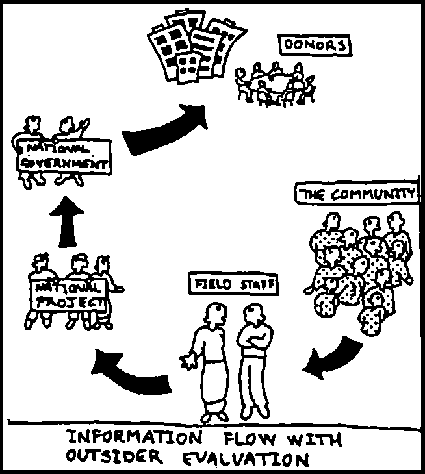
Information flow possible with participatory evaluation
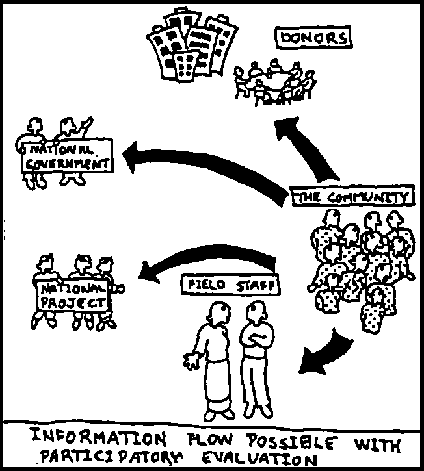
Insider to insider communication is strengthened
Participatory Evaluation can be used for local extension, with results presented to other communities who are experiencing the same kinds of problems. In this way insiders learn from insiders.
Information is useful for ongoing management of project
Information from Participatory Evaluations can be used by insiders and outsiders to identify strong and weak points of activities. If activities are to be continued, or phased over to insiders, information can be used to modify activities and make them more effectively meet objectives, and better respond to real community needs and priorities.
Entry point for the participatory approach
In a community where participation has not been a feature, Participatory Evaluation may be the beginning of a participatory approach. It may be that including school children in the process not only helps the community gather information, but also helps the children develop analytical skills and experience
School children can collect information
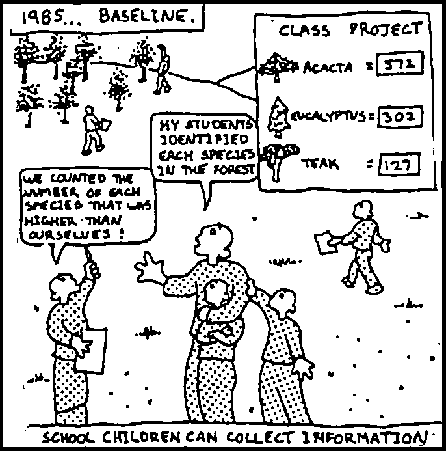
And learn about forest!
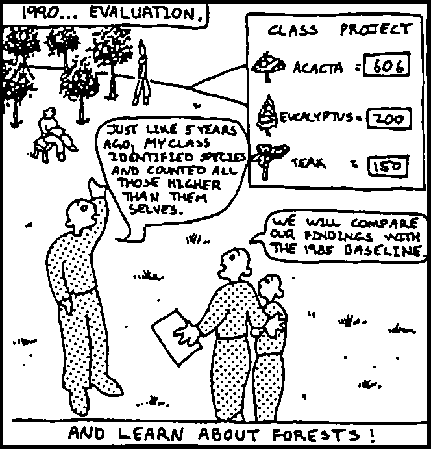
| Participatory Evaluation may be done: Because they have been planned Participatory Evaluation can be planned for set times through out the life of the activities. These can be mid-way through the activities, or after each season of planting, depending on when the community decides it needs to Stop and examine past performance. Because there is a crisis Participatory Evaluation can help to avoid a potential crisis, providing a chance to discuss important issues. For example, suppose an area of common land had tradition ally been used by the landless group to collect fuelwood and graze their animals. Without consulting this landless group, the activities implemented by other community members have fenced and planted trees on this communal land. The landless group have vandalized the fence, and allowed their animals to graze, destroying the newly planted trees. Bringing people together to discuss and mediate a solution can be done using a Participatory Evaluation. Because a problem has become apparent Problems, such as a general lack of community interest in the activities may be realized. Participatory Monitoring may provide more information that can help people determine why there is a problem and/or how to remedy it.. It participation is new A Participatory Evaluation may shed some understanding on why a project isn't working very well. The results of a Participatory Evaluation may be the entry point for a more participatory approach. If participation has not been a feature of the project, outsiders who are experienced in participatory evaluation approaches may be very useful, as they can sensitize and train field staff in this approach, facilitating the evaluation. |
3. Steps to participatory evaluation.
The time that is taken to carefully prepare and plan a Participatory Evaluation is time well spent. It helps everyone know why they are evaluating and how they are going to do it.
The first meeting to prepare and plan the evaluation should be open to all interested groups (see Tool 1: Groups Meetings). This meeting could include beneficiaries, others in the community, as well as groups from outside the community who have an interest in the project.
If a great number of people are interested in the evaluation, some of the responsibilities of the evaluation can be delegated to a small group, a community evaluation team. But the larger interested group, at this first meeting, must first discuss why they are doing an evaluation and what they wish to know, in order to provide guidance to the community evaluation team.
| First step 1 |
Review objectives and activities.
The larger group, as described above, decides why an evaluation is necessary.
The community's long-term and immediate objectives and the activities they have chosen to meet these objectives can be reviewed at this meeting. If PAME has been used, the objectives and activities established during the Participatory Assessment can be reviewed. If the activities have not been participatory, the objectives, as established by outsiders, can be reviewed.
Review objectives and activities
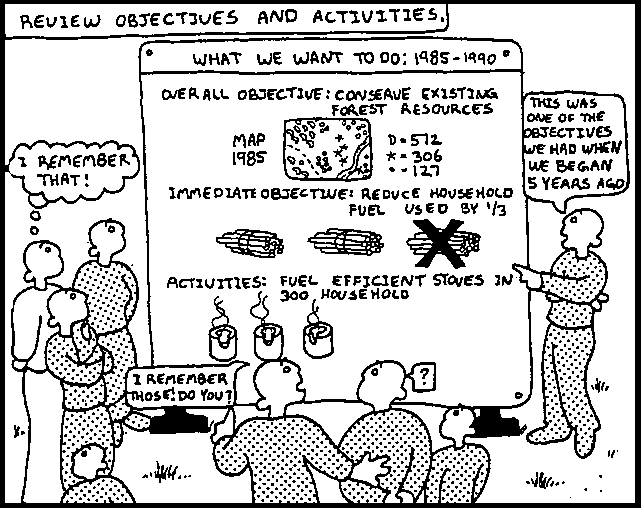
| Second step 2 |
Review reasons for evaluation.
After objectives and activities are reviewed, discussion can focus on the questions:
"Why are we doing an evaluation?"
"What do we want to know?"
Review reasons for evaluation
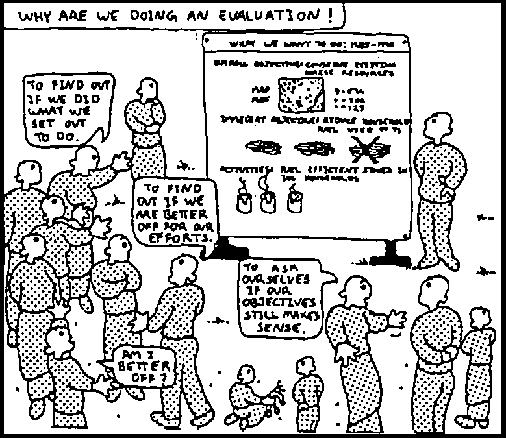
| Third step 3 |
Develop evaluation questions.
Develop evaluation questions
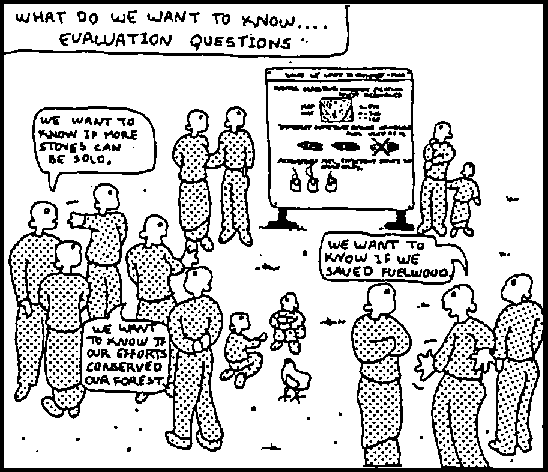
The facilitator can write (or draw), the evaluation questions on large sheets of paper or a blackboard. The group should agreed on each question. If many questions are generated around each objective and activity, they can be ranked in order of importance.
| Fourth step 4 |
Decide who will do the evaluation.
In the larger group meeting, decide who will do the evaluation, and who will want to know the results. It may be decided to include the whole community (especially if it is small), only the beneficiaries, or delegate the responsibility for the evaluation to an evaluation team. The composition of the evaluation team should be decided by the larger group at this first meeting. If it is known that some minority groups will not be represented, the facilitator may encourage the participation of spokespersons from these groups on the evaluation team. The evaluation team may include beneficiaries, those who may be disadvantaged by an activity, community members and other affected groups.
The larger group also decides who needs the results of evaluation, and when the results should be ready. This will depend on who needs the information to make decisions, and when decisions are to be made.
| Fifth step 5 |
Identify direct and indirect indicators.
Taking the evaluation questions that were generated in the first meeting, direct and indirect indicators are chosen for evaluation questions.
A description of "direct and indirect indicators" is presented in Chapter 3.
| Sixth step 6 |
Identify the information sources for evaluation questions.
For each evaluation question and indicator that is chosen, the evaluation team identifies where information is available, or if it is not available, how it will be obtained. Some information may be available in an unanalyzed form, and require some effort to analyze. Other information may not be readily available, and will have to be gathered.
The information that is required may be available from either Participatory Assessment, Participatory Baselines, and/or Participatory Monitoring.
Identify the information sources for evaluation questions
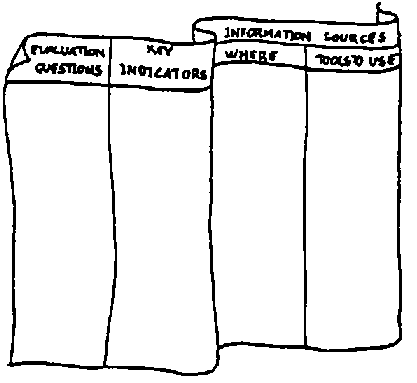
If information is not readily available, it must be decided which information gathering tool will be used to obtain information. Remember it is possible to use one tool to gather information for a number of indicators. Some of the information gathering tools useful in Participatory Evaluations are:
| Tool 7 | Community Case Studies |
| Tool 9 | Semi-structured Interviews |
| Tool 10 | Ranking, Rating and Sorting |
| Tool 11 | Community Environmental Assessment |
| Tool 12 | Survival Surveys |
| Tool 15 | Farmer's Own Records |
| Tool 16 | Nursery Record Books |
| Tool 17 | Community Financial Accounts |
| Tool 18 | S.W.O.L. Analysis |
The choice of tools will depend on the kind of information needed. If an information gathering tool has been used before, it may be used again to update the information and show change.
| Seventh step 7 |
Determine the skills and labour that are required to obtain information.
The assistance of people with specific skills, such as interviewing, mathematics, art and/or drama, as well as a certain amount of labour (time) will be required.
The evaluation team must decide which skills and resources are available to them. They might ask the questions:
What resources do we need?
What resources do we have, or can we develop?
What other resources do we need to get?
Determine the skills and labour that are required to obtain information
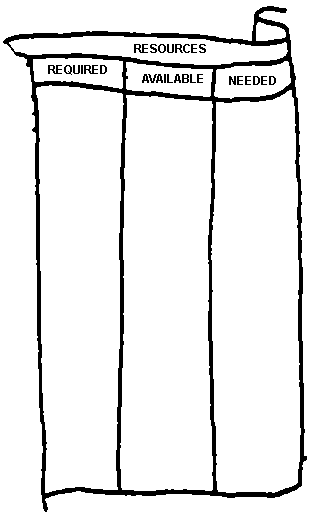
| Eighth step 8 |
Determine when information gathering and analysis can be done.
It is important to assure that information will be gathered and analyzed within the time frame that is given to the evaluation team, so that the results can reach decision makers on time. The timing of the evaluations must take into account factors such as: seasonal constraints (planting and harvesting times); religious holidays; field staff availability; and community labour demands.
For each tool that is used, the evaluation team decides approximately how long each task will take, and when it will be done.
| Ninth step 9 |
Determine who will gather information.
When the specific dates, the required time and skills are known, then the tasks can be delegated to individuals or small working groups.
| Tenth step 10 |
Analyze and present results.
When all the tasks have been completed, it will be necessary to analyze and synthesize information for presentation. Some of the information may already be analyzed. It will simply have to be put in its place in the presentation. Many of the information gathering tools, such as case studies or popular dramas, lend themselves to certain types of presentation. Analysis and presentation of results is the subject of Chapters Six and Seven.
The evaluation team can decide what will be the best way to present results, given the audience for whom the results are intended, the resources and time available.
Evaluation framework
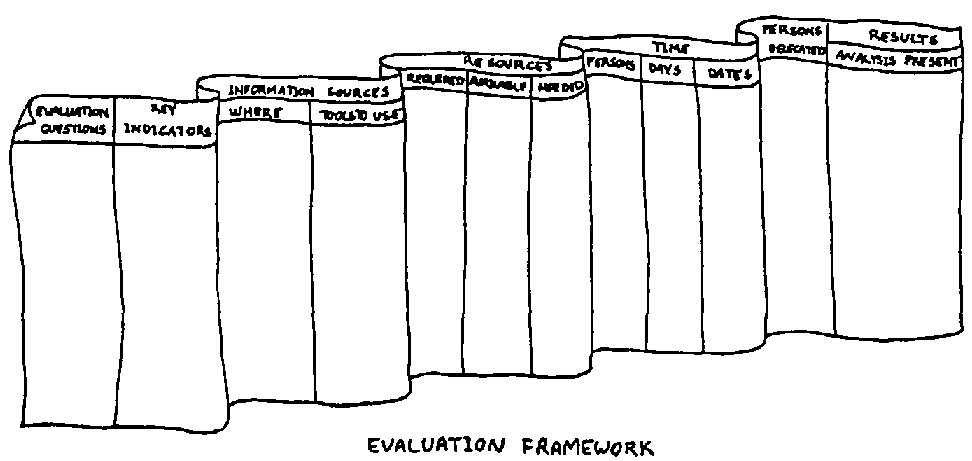
Chapter six :Information analysis
Analysis is examining information (sorting it out, adding it up, comparing it) in order to understand the "parts" in relationship to the "whole".
The parts
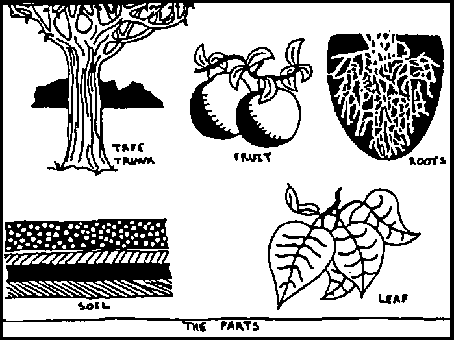
The whole
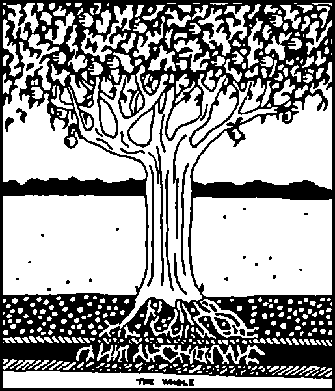
Both insiders and outsiders contribute
Insiders and outsiders together plan the analysis. This helps ensure that information is comprehensive, valid and understood.
Analysis may be included in information gathering
Some of the analysis may have already been done, or partially done, depending on which information gathering tools have been used.
For example, suppose the Ranking, Rating and Sorting Tool (Tool 10) is chosen to answer the question: "which tree species do farmers prefer to plant with their crops?" Using this tool, a list of ten species, from most preferred to least preferred, has been produced. This information is already analyzed. It only needs to be examined along with other information, such as the species farmers request from the community nursery.
Partial analysis
If a team has been given responsibility for the analysis and are to present their results to the larger community group, presenting the information in partly analyzed form can be very effective.
The benefits of partial analysis are:
• the larger group has an opportunity to contribute to analysis;
• the results are validated by more people and will be more reliable;
• the analysis process is understood by more people.